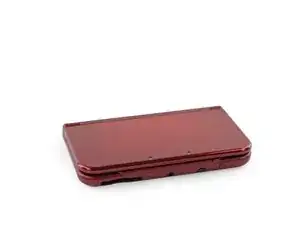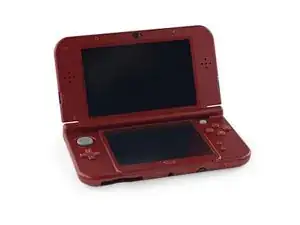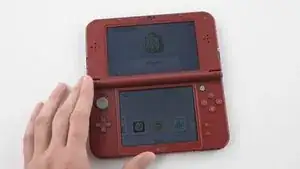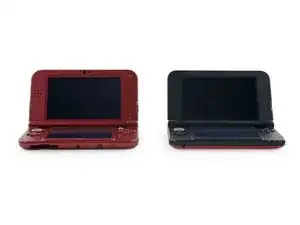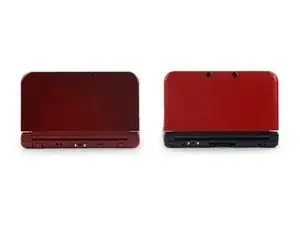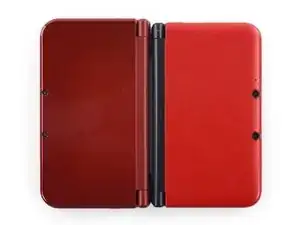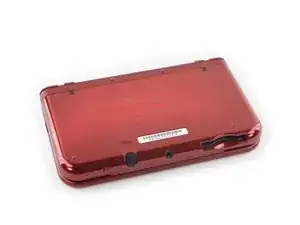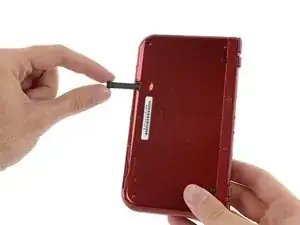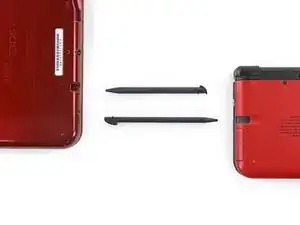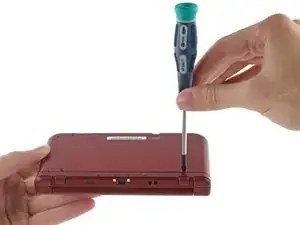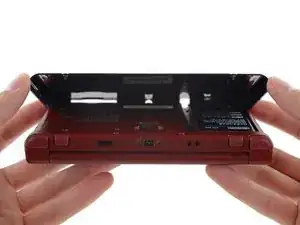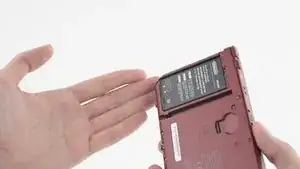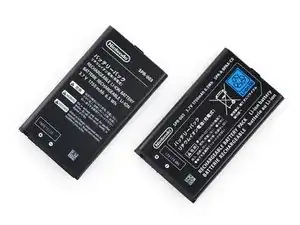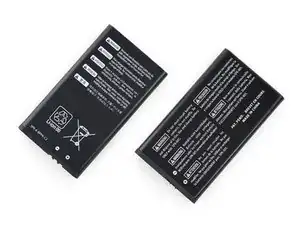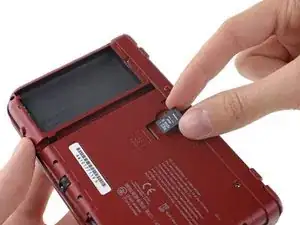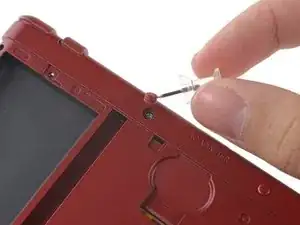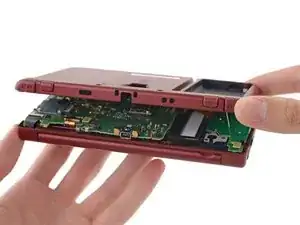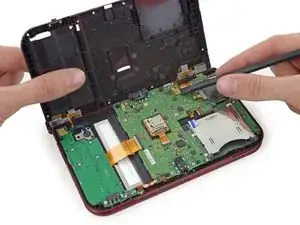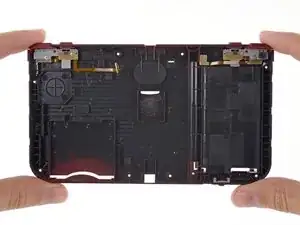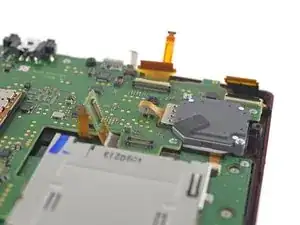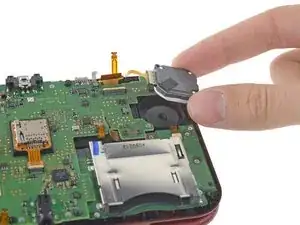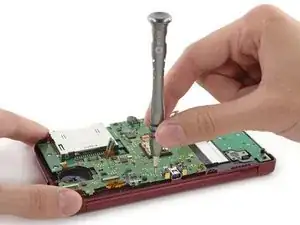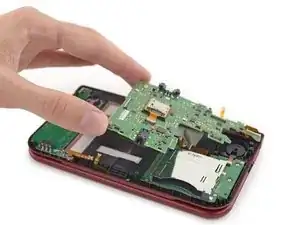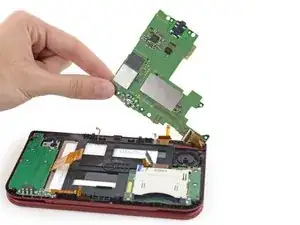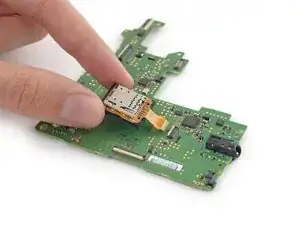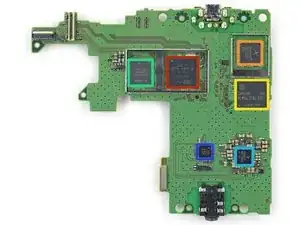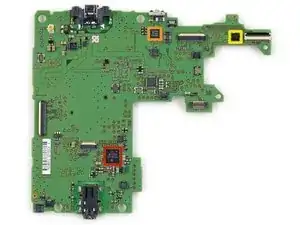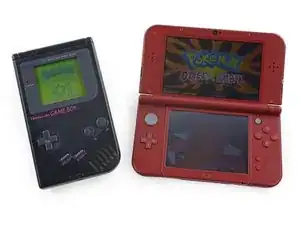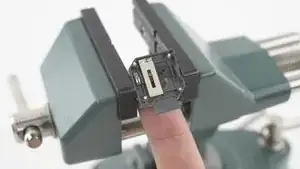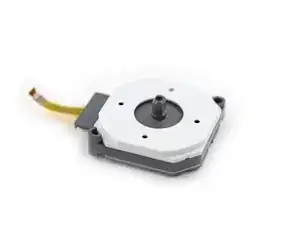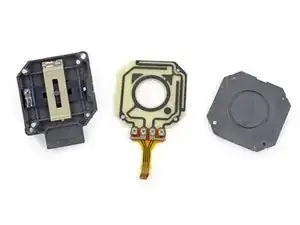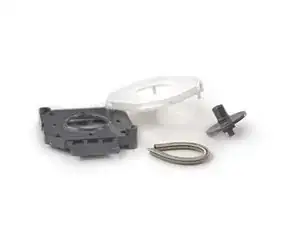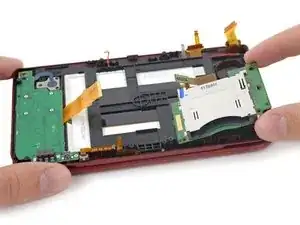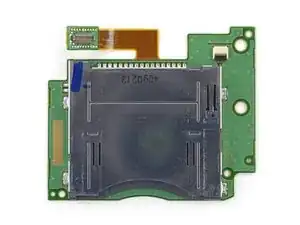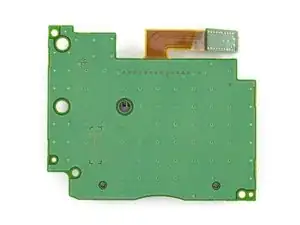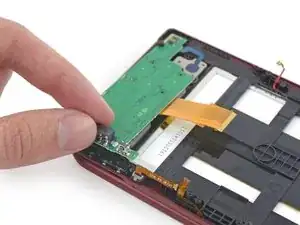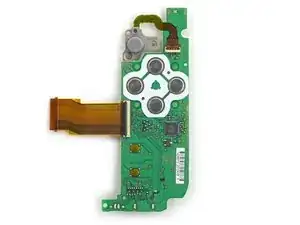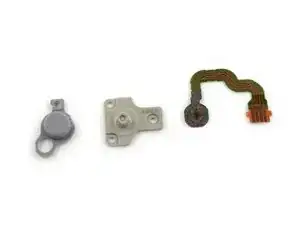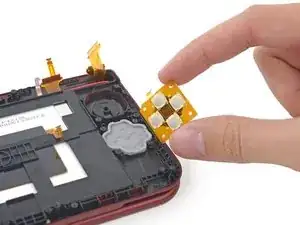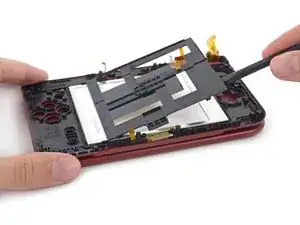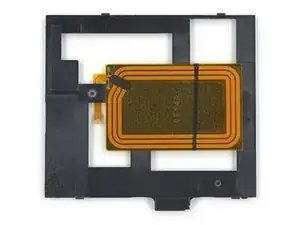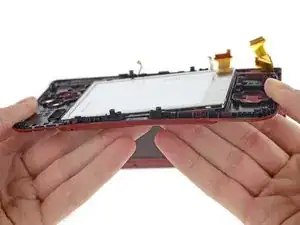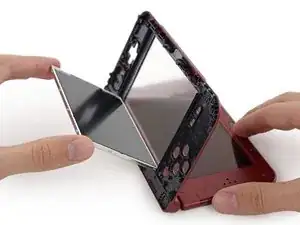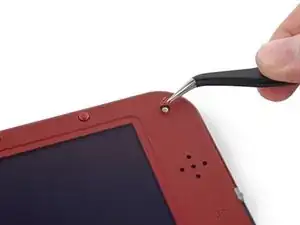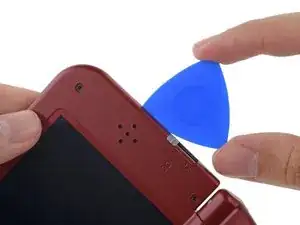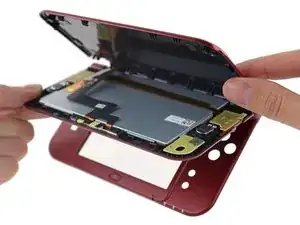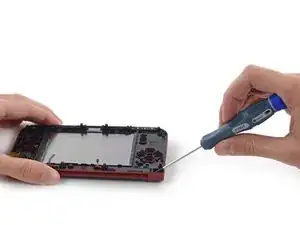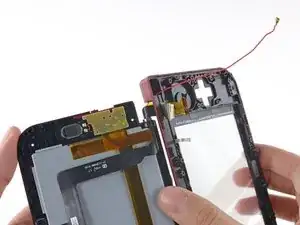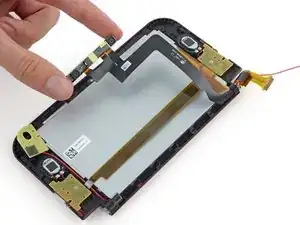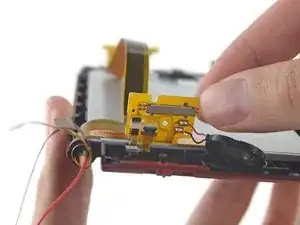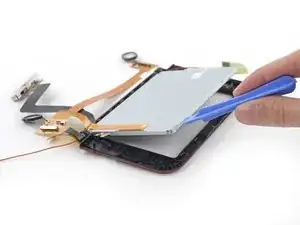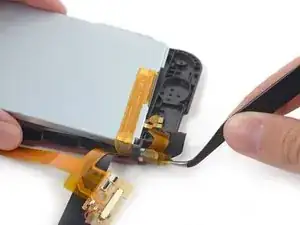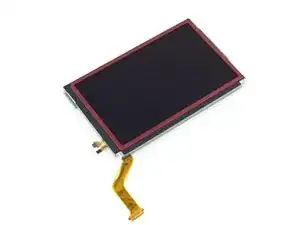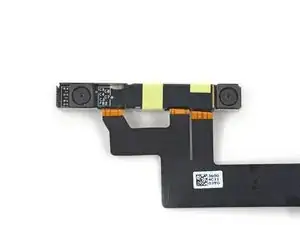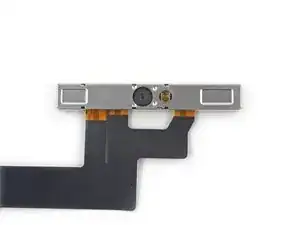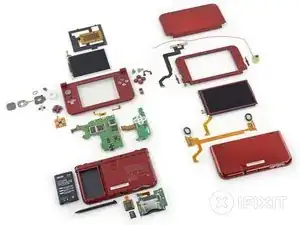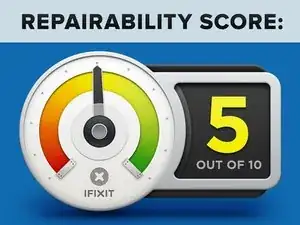Werkzeuge
-
-
We braved a gnarly midnight line at our local GameStop to bring you this teardown. No expense was spared for your enjoyment.
-
Hot off the press, the Nintendo 3DS XL 2015 boasts the following tech specs:
-
"Super-stable, face-tracking 3D"
-
Addition of the C stick along with new ZL and ZR buttons
-
Built-in near-field communication (NFC) reader
-
Improved CPU performance
-
Upgraded rear-facing cameras and microSDHC support
-
-
-
It's time for a face off between the New 3DS XL, and its older brother, the original 3DS XL.
-
Perhaps the biggest change is the shifting of the cartridge slot to the front of the device, making room for the new ZL and ZR buttons.
-
It looks like the New 3DS XL has lost some weight too! Weighing in at 329 grams, Nintendo has shaved 7 grams off of the original 336 gram weight.
-
The New 3DS XL is also slightly larger and thinner, coming in a 160 x 93.5 x 21.5 mm vs the original 156 x 93 x 22 mm.
-
Also the new one is shiny.
-
-
-
It's a bit hard to see, but there's a very subtle moiré pattern on the New 3DS XL's shiny exterior.
-
The back cover shows off the usual disclaimer/manufacturer imagery, telling you this is the *New* version and not the old one.
-
You'll have to remove the stylus before disassembling your New 3DS. After pulling it out, we noticed it to be a bit different than the old one.
-
It's the same weight as the old one—1.8 grams, according to our
dealerprecision scale. Yet, it's a bit stubbier, and feels a little cheaper.
-
-
-
That's right, you need a frickin' screwdriver to replace the (now micro) SD card. Gone are the days of flappy door access.
-
And once you're inside, the card and battery are easily accessible.
-
And very easily removable...
-
-
-
Battery removal and installation in 3 seconds. Hey Apple, take note. This is how it's done.
-
-
-
Two teardowns for the price of one! We never gave you an original 3DS XL teardown (although we have many lovely guides), so here's the skinny on batteries, at least.
-
On the left is the New 3DS XL battery, with the "old" 3DS XL battery on the right.
-
It seems Nintendo didn't bother upgrading the battery in the New 3DS XL. Both models feature a 3.7 V, 1750 mAh battery rated at 6.5 Wh.
-
-
-
All it takes is a push from a fingernail to get the micro SD card out of its tiny house. So out it went with little effort on our part.
-
Speaking of removing the micro SD card, if you're upgrading from a 3DS, 2DS, or 3DS XL, check out our (and Nintendo's) guide on how to transfer your data.
-
Nintendo hid two screws under a couple of rubber feet; the other six were exposed when we removed the bottom cover. We've been in this game long enough to not fall for that hidden-screw trick.
-
We push-pinned those little rubbers out of the 3DS, and presto-blamo — cracked it open!
-
-
-
What "new" magic awaits inside the New 3DS XL? Let's find out!
-
The flappy shoulder bumper buttons stay in the lower case, so we employ a bit of cable-spudgering to separate the pieces.
-
It looks like Nintendo doesn't care much for internal appearances — they left some uncured powder coat on the interior of the lower case.
-
-
-
Okay, what Ouroboros business is going on here?
-
The circle pad cable is weirdly wrapped over its own ZIF connector, hindering access to...itself.
-
Our first inclination was to disconnect the ZIF connector and proceed with removing the motherboard. But it's such a tiny, frail connector, and cable, that we decided to remove the assembly first.
-
Out the circle pad goes! More on that in just a jiffy — first we focus on the motherboard.
-
-
-
Once we got inside, our trusty Phillips drivers started to mysteriously let us down—these screws seemed to be in between two sizes.
-
Surprise, they're JIS! Now, where do we get ahold of a JIS bit...
-
With our driver properly equipped, the motherboard comes flying out without delay...
-
...or not? There's not one, but two cables attached to the rear of the motherboard, just to make things tricky.
-
-
-
It's time for some motherboard action!
-
Nintendo 1446 17 CPU LGR A (custom CPU, likely based on an ARM core)
-
Atheros AR6014G-AL1C Wi-Fi SoC
-
Samsung KLM4G1YEMD-B031 4 GB eMMC NAND Flash
-
Fujitsu 82MK9A9A 7LFCRAM 1445 962 FCRAM (Fast Cycle RAM)
-
Texas Instruments 93045A4 49AF3NW G2 (Possibly Power Management IC)
-
Renesas Electronics UC KTR 442KM13 TK14
-
-
-
The back of the motherboard has a few goodies as well.
-
Texas Instruments AIC3010D 48C01JW (Possibly Codec IC)
-
NXP S750 1603 TSD438C Infrared IC
-
Texas Instruments PH416A I/O Expander
-
-
-
Break time: We did a quick reassembly, followed by a nostalgia overload.
-
Now that the tech writers are fed and caffeinated, we'll be moving on...
-
-
-
Hey guys, ever wonder how a circle pad works? Yeah? We did too!
-
Allow us to present to you Xzibit A: the internals of the circle pad. Here it is in action.
-
But wait, there's more!
-
-
-
The circle pad consists of a small, donut-ish PCB with traces, a backing plate, and the spring-loaded X-Y sliders.
-
The X-Y sliders each have two metal contacts that are always touching the PCB.
-
As you move the sliders up/down and left/right, the metal contacts are adjusting the resistance of the circuit on the PCB.
-
This, in turn, is registered as movement in whatever game you're playing.
-
Regarding the spring-loaded sliders: A spring inside the mechanism makes the "stick" always return to center. If you wanted to convert the circle pad to more of a "throttle" type joystick — where it doesn't return to center automatically — all you would have to do is take the circle pad apart and remove the spring found within.
-
-
-
Ah, the game cartridge reader. It sure does bring back memories of the good 'ol days of blowing into the cartridge reader.
-
-
-
Oh hey, the button board comes out!
-
The ABXY buttons are right on the board, but the C stick can come and go as it pleases.
-
Said C stick doesn't actually move or push anything, and therefore seems to be powered by magic.
-
You nudge it with your finger, and the 3DS just knows. Our best guess is that this actually uses strain gauges to sense how hard you're pushing.
-
-
-
With the cartridge reader out of the way, we easily remove the D-pad buttons.
-
(Shake, Shake, Shake) Shake Your Buttons.
-
-
-
The lower screen has a large black frame, perhaps as a defense against over-eager tapping.
-
This frame also houses what appears to be the NFC antenna for Amiibo figurines.
-
Always one to stay hip with the kids, Nintendo has expanded beyond AR cards to the collect-to-game cash cow.
-
-
-
Poppin' the lower LCD off some adhesive seems scary, but isn't too bad. No heat required!
-
The plastic LCD cover is threaded with a very-faintly-visible grid of dots. We didn't notice it at first, and taking a photo of it is near impossible — but it's there! We promise!
-
-
-
Four hidden screws and plastic clips along the perimeter hold the secret to its undoing.
-
Our opening pick makes the perfect tool for prying apart the two halves of the top case.
-
Want to see pictures of our cats? Nah, just kidding, that's not a wallet, it's the back of the LCD. These are our cats.
-
-
-
It is here that we realize the 3DS XL is basically built like a giant flip phone.
-
One side of the hinge is held together with a pin, and the other is hollow to allow the display, audio, and camera, and antenna cables through.
-
With the hinge pin popped, the lower assembly slides off the hollow pin, and the cables take refuge in a slot, ready for separation.
-
-
-
Let's just remove the camera bar. Oh wait.
-
There are several cables leading into the side of the display assembly. Our bet is that these control the parallax barrier, used to generate that awesome glasses-less 3D effect.
-
What's a parallax barrier? Imagine placing a very small picket fence in front of your screen, so that when you look at the display, each eye sees different pixels while they peer around the fence boards.
-
Then, with a combination of the magic of geometry, and the new face-tracking "super-stable 3D", the 3DS knows which pixels each eye can see, and draws two overlapping versions of the same scene—one for each eye. The combination of these two versions gets slapped together in your thinkpan as a sweet, sweet stereoscopic 3D image.
-
-
-
Good news: The display assembly is only mildly adhered to the frame, meaning we can pop it free with little effort.
-
Bad news: Its ribbon cable, and two others, are routed through the hinge, and need to be rolled up and pulled through in a horrible, painstaking, risky maneuver.
-
But then it's free!
-
-
-
Front and rear camera(s) bar! Nintendo combined all three cameras into a single bar and cable.
-
The front camera is watching your every move, in an effort to serve you the best possible 3D with the least possible jitter.
-
The dual rear-facing cameras track AR cards, and take photos with apparently improved low-light capture.
-
Sadly, there isn't much component information here. There are no tell-tale inscriptions on either camera board or cables, aside from a vague QR code label that reads "3600 4C11 03YG."
-
-
-
Nintendo 3DS XL 2015 Repairability Score: 5 out of 10 (10 is easiest to repair)
-
The battery is fairly easily swappable by unscrewing two screws and removing the back cover.
-
Screws and plastic clips are the primary fasteners, rather than adhesive. Also, no Proprietary screw types are used—only Phillips and JIS.
-
The top display's cables are routed in such a way that it makes them quite frustrating to remove without ripping them off, and just as difficult to re-seat properly during device reassembly.
-
There are tons of little components inside the 3DS, which may potentially cause problems if you happen to lose one while performing a repair.
-
The majority of connectors are ZIF, and it's difficult to ensure each one is connected properly without reassembling the whole thing and starting up the device.
-
The headphone jack and charging connector are soldered to the motherboard, meaning you need to take out your soldering iron if you accidentally break them.
-
41 Kommentare
Anyone know if some 3rd party will make case bottoms with a SD card slot on the side via a simple cable?
Not until someone knows how to reverse engineer the motherboard and the MicroSDHC card slot PCB parts. After that, 3rd party components will be available, but it's still risky business/corporate-wise.
Looking at console replacement cases theres not much to do other than match up screw holes and the MICROSD card itself is done via a ribbon/super flat cable connected to A MICRO or normal SD port on the side of the replacement case, no need to rebuild the electronics since its just an extension to the MICROSD port. The replacement case would be a slightly different size but exterior size is not that big of an issue.
********Note: If your top or bottom screen was working before disassembly and doesn't work after reassembly, then it's likely that the connector is loose or dirty or damaged or not clipped or PLACED UPSIDE-DOWN. I had this issue with my Super3DS XL(2015 New3DS XL) and it turns out that the reason why my top screen wasn't working after put together, was because I had the top LCD connector upside-down. After I correctly put the connector in, It worked again! :) ********
On step 23: All portable Nintendo's since the original DS have "sliding clips" for the top screen, ie. you have to slide the outer cover slightly up to open it. This way, no efforts or tools are needed (assuming the "hidden" screws are already out). From the pictures, it looks like it's still the same for the new 3DS XL you opened, or am I wrong?

